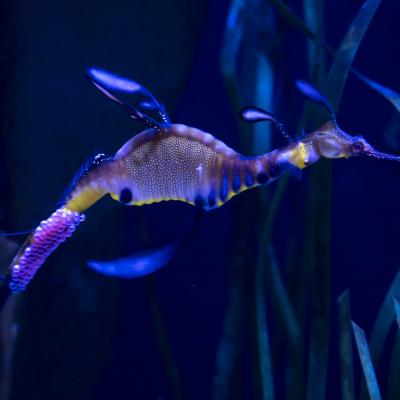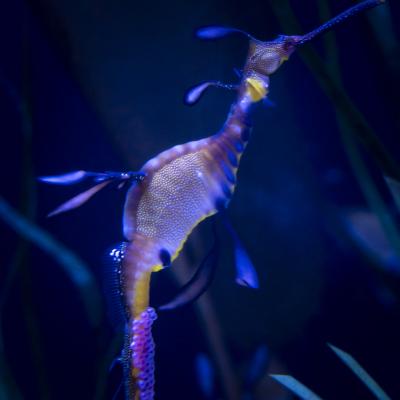NOTE TO MEDIA: Photos and video are available through this Dropbox link. Photo credits are found in the file names (example: Grahm S. Jones, Columbus Zoo and Aquarium).
POWELL, OH — Just over a year after welcoming weedy seadragons to the Columbus Zoo and Aquarium’s Australia and the Islands region, an attentive weedy seadragon father—with the support of the Zoo’s Shores & Aquarium team who provides care for this species—successfully hatched 26 weedy seadragons (or “weedies”). This milestone places the Columbus Zoo among only several other North American zoos and aquariums that have marked this significant achievement.
Unlike most other species, for seadragons, the dads carry the important task of helping to bring babies into the world by fertilizing the eggs and carrying them on their tails until they are ready to hatch. The successful egg transfer from a female to the male’s tail is a delicate process, and the fact that this occurred at the Columbus Zoo even once was already a cause for celebration, in addition to the subsequent hatching. In fact, a second pair of weedies also achieved a successful egg transfer, though the eggs dropped from the male’s tail a few days later, preventing them from further developing.
As the hatching date range for the egg-carrying male approached, the Animal Care team then moved the soon-to-be father behind the scenes to keep a closer eye on him and the eggs. Between June 24 and July 4, 26 weedy babies (or “fry”) were welcomed into the world.
With the new father’s responsibilities of protecting the eggs then complete, the care team moved him back into the weedies’ main habitat inside the Nocturnal Building and Aviary. The fragile inch-long hatchlings are being raised for at least one year behind the scenes, where the expert Animal Care team continues to provide all aspects of care for the babies. The care team reports that the baby seadragons have a voracious appetite and are eating approximately 9,000 baby mysis shrimp and 18,000 copepods (planktonic crustaceans) per week. The care team remains cautiously optimistic that the young seadragons will survive and thrive. While a few have passed away, this is not uncommon. Typically, only five percent of seadragons survive their first year in their native range.
“Seadragon babies are incredibly fragile, delicate animals, and I’m so excited they are thriving in their new home and in our expert team’s care,” said Columbus Zoo and Aquarium President and CEO Tom Schmid. “We hoped they would breed, but the fact that it successfully happened this quickly is amazing and a real testament to the team’s knowledge and dedication.”
Weedies are relatives of seahorses and are a notoriously difficult species to breed. They have long, slender bodies and leaflike appendages that help them blend with seaweed. They grow to be 18-inches long and without teeth, rely on their tube-shaped snout to suck food in, like a straw. Native to the southern and eastern coasts of Australia, the ability to camouflage and blend with their environment helps them avoid detection by predators and scientists alike.
While not classified as threatened in the wild, they are considered vulnerable due to warming oceans and destructive fishing practices—reasons why breeding and studying seadragons is important.
Part of the challenges with breeding stems from their elaborate mating ritual. The males and females mirror movements but with tails curled away from each other. When they rise up in the water column, the female transfers eggs on the underside of the male’s tail, unlike seahorses, which have a pouch instead. The male fertilizes the eggs and carries them 6-8 weeks until they hatch.
“There is relatively little known about this secretive species in their native range and across conservation organizations,” said Becky Ellsworth, Curator of the Shores and Aquarium region. “The information we are gathering throughout this rare opportunity will add to the collective body of knowledge and wellbeing of weedies worldwide.”
For additional updates about the Columbus Zoo’s conservation initiatives, events, and more, follow the Zoo’s social media accounts on Facebook, Instagram, X, and TikTok, and visit us at ColumbusZoo.org.
###
About the Columbus Zoo and Aquarium
Home to more than 10,000 animals representing over 600 species worldwide, the Columbus Zoo and Aquarium leads by making a positive impact on people, wildlife, and wild places. The Zoo complex is a recreational and educational destination that includes the 22-acre Zoombezi Bay water park and 18-hole Safari Golf Club. The Columbus Zoo and Aquarium also manages The Wilds, a 10,000-acre conservation center and safari park located in southeastern Ohio. The Zoo is a wildlife conservation organization with regional, national and global impact, annually supporting conservation and research projects locally and worldwide. For more information, please visit ColumbusZoo.org.













